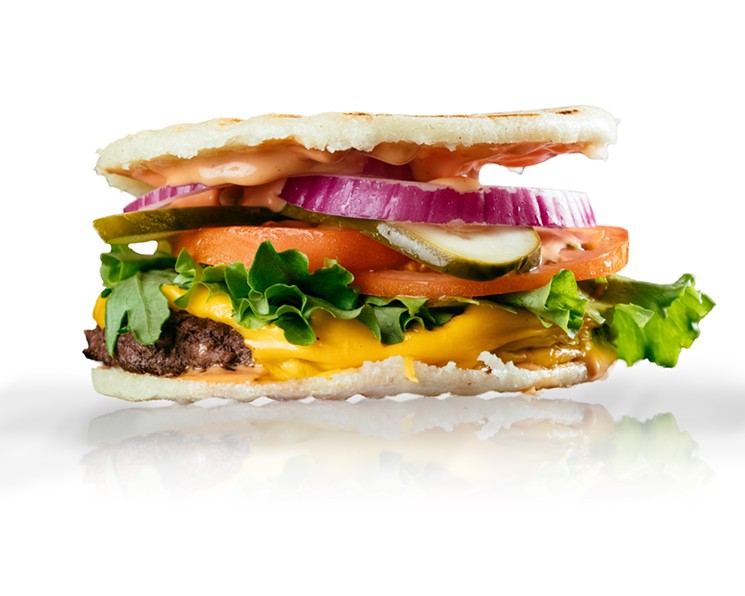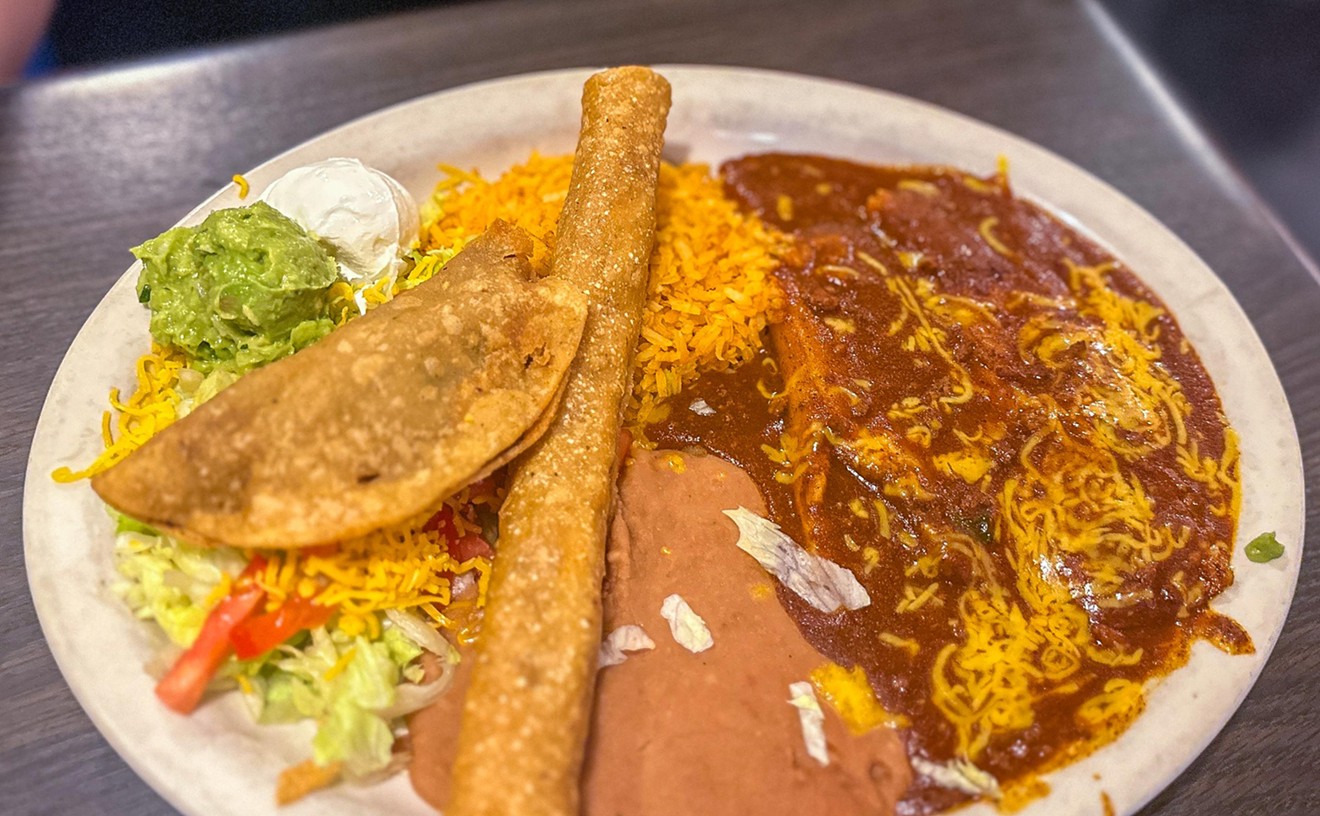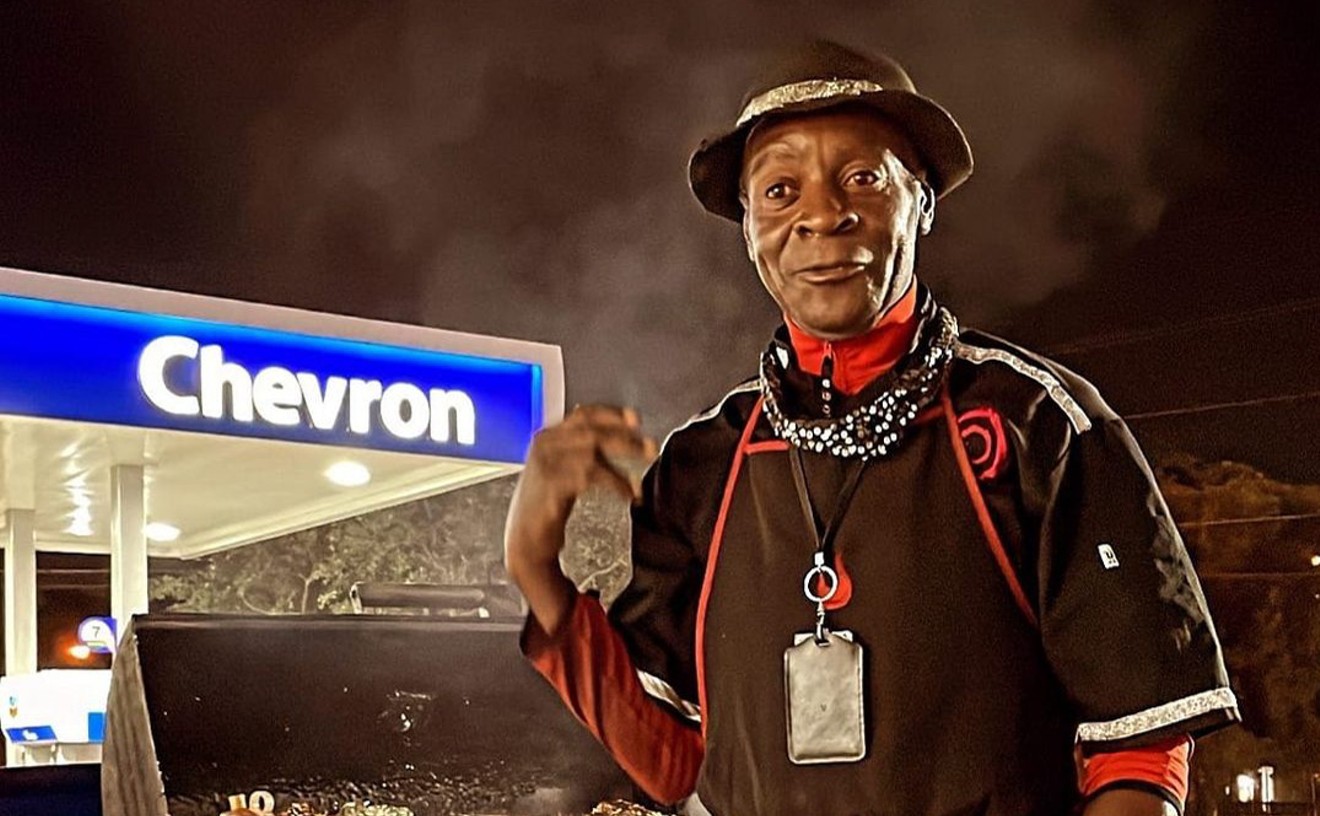It's been about eight months since Bryan and Kathy Crelly added America’s most sophisticated and edible plant-based “burger” tech to their menu, and they’re completely sold out. The first iteration of the technology, the Impossible burger 1.0, tasted like biting into a disc made of wet leaves.
This burger was an amalgam of soy and potato proteins suspended in coconut and sunflower oil and laced with a network of heme molecules. Heme systems color your blood red. Heme molecules are also responsible for that satisfying-to-your-marrow sensation in beef: It hosts that electrifying umami that lights the meat part of your brain like a Christmas tree. During a tasting at Hopdoddy, the Impossible 1.0 squished like a forest floor after a rainstorm. It wasn’t good.
Whether you like the Impossible 1.0 or would be happier hurling it into White Rock from a moving car, the Impossible Burger has already rooted deep into one demographic: The carnivores who are hoping to eat less meat. At Crelly’s sandwich joint, Uncle Uber’s — one of a handful of local joints (not nationwide chains) that offer the plant-based patty in DFW — the Impossible has found a home.
Just offering the patty has increased traffic to the Deep Ellum sandwich joint, the Crellys say. Some Impossible regulars alight their plant-based disc with American cheese and bacon. Bryan says that he’s witnessed wanderers from The Bomb Factory, the concert venue across the street, amble in to purchase the Impossible patties a la carte. These Impossible ravagers have been known to take the burger patties to-go and cook them at home. Other Impossible regulars call ahead to confirm that Uncle Uber’s is fully-stocked with the not-meat patties before they arrive.
It’s midway through the week, and the Uber family’s stockpile of Impossible burgers is empty. Bryan says he’s picked up the phone to reach Impossible Foods multiple times.
“We keep calling them and they keep saying, oh no, it might be a little time,” Bryan says. “I think they bit off more than they could chew with Burger King.”
Right around April Fool’s Day in 2019, Burger King announced a new breed of Whopper that employs the meatless tech of the Impossible burger 2.0, the “next generation version,” would be available at roughly 60 Burger Kings in the St. Louis area. The radius is starting small. This news dropped weeks after Impossible Foods announced an “accelerated launch” of Burger 2.0 at 200 stores across the U.S.
Hopdoddy, which has locations in Dallas, was one of the burger joints that made the first cut.
A burger with a sense of place
“It’s interesting,” she exhales. “It’s good ... When we opened, we might have been a little bit ahead of our time.”
A cheeseburger was not on the menu, in any way shape or form, when she had first envisioned the restaurant Start. It was 2012 in Dallas, and she found herself driving around, her kid in the backseat roiling with hunger, in a wild search for food that wouldn’t super soaker-hose her child with sodium, sugar and carbs. Once McKool’s idea — a drive-thru joint that serves the fast food the way it was meant to be, clean, real and honestly sourced — took root, it was only a month before opening that she added a cheeseburger. In other words, the burger was a last-minute add.
It’s easy to imagine why McKool would take the burger plunge. In summer 2012, the humble cheeseburger, one of humankind’s Valhalla creations alongside Mount Rushmore, the pyramids and those self-cleaning litter boxes, was about to enter its golden age in Dallas. American cheese leapt onto menus and out of our youths in Dallas’ high-end bars. One burger in Dallas’ glistening One Arts Plaza had a stretchy Kraft Single glistening atop a house-ground, just-under-20-buck lunch burger.
The Big Mac was an inspiration for, at minimum, five of Dallas’ best burgers in the city, right down to the sesame seed bun. Many of those are long gone, like the double cheese at Deep Ellum’s Filament. It’s a stone’s throw from Uncle Uber’s, where a thin-pattied double cheeseburger, less than 10 bucks, is stellar. The new thing was an homage to old thing: the pre-celebrity chef, no-frills burgers you devoured in the backseats of cars as a kid. In 2019, house-made secret sauce still runs through the streets like rain after a Texas thunderstorm.
“I think people are becoming a lot more choosy,” says McKool, who offers a grass-fed burger from Burgundy Pasture Beef at the drive-thru. “They still want a burger, though.”
When you pull in to the drive-thru, McKool’s concept still feels like a landmark idea. Swing in front of the outdoor menu, car rumbling, and get a grass-fed cheeseburger made-to-order. Yes, you’ll wait a few minutes. Recently, McKool added a brunch slider. The tater tots are the only frozen item — not many restaurants make their own. The grass-fed burger will drop into a paper sack after a light wait. The secret sauce won’t even lacquer the bag translucent with grease. Start isn’t that kind of restaurant. There’s even a paper straw jutting through your compostable cup.
So, can Start be the future? Dallas beef from a batch of Dallas-area cows — the kind you could drive to the farm on a Saturday and ask how the cow’s week was — served in minutes through a drive-thru window?
It’s easy to imagine the literal robotics of a clean and local burger joint in a couple of decades: What if the kitchen were run by robotic arms, dispensing griddled happy cow discs through a slat in the window after the flat, pre-recorded greeting from the unseen voice?
But are beef burgers, grass-fed or not, even sustainable?
“We’re doing a really good burger, and it’s sustainable for this little pocket of the world,” McKool says. “... But people need to start changing their eating habits. We can't keep eating meat every day.”
In 2014, a study published in the PNAS (Proceedings of the National Academy of Sciences of the United States of America) declared that the cost docked from the environment for poultry, pork and egg production is “strikingly lower than the impacts of beef.”
“Beef production requires 28-, 11-, five- and six-times more land, irrigation water, GHG (Greenhouse Gas), and Nr (Nitrogen), respectively, than the average of the other livestock categories.”
In 2018, the World Resources Institute published a graphic illustration what earthlings could save if we replaced our burgers with 30% mushrooms. In it, they claim that Americans eat 10 billion burgers every year.
Even a casual Google search for a guilt-ridden burger lover details the number of scars that beef production has left on the planet. The water this kind of mass production sucks from the ground, and the gas cows expel into the atmosphere, is hot-boxing the planet. In a Freakonomics Radio podcast called “The Future of Meat,” Pat Brown, CO and founder of Impossible Foods, claimed (without citing evidence) that “the most environmentally destructive technology on Earth” is the harvesting of animal products. “Nothing else even comes close,” he says.
Brown’s wish, he states in the podcast, is to snap his fingers and animal production would cease to exist.
Sure, OK, the Thanos of the food world may rub people the wrong way. At minimum, we could argue that he’s trying to understand our dire landscape. It doesn’t take an advanced biochemistry degree to see the problem coming: Depleting resources won’t stop depleting if we continue to down triple cheeseburgers everyday.
Meanwhile, rescue efforts are brewing.
Food fast, but not fast food
Reyna Duong, chef and owner of Sandwich Hag, does not serve a single morsel of beef at her restaurant. She grew up surrounded by dishes like Vietnamese pork balls, studding a bed of thick noodles and bean sprouts and splashed by coconut milk and rich, dark fish sauce. Her banh mi are fresh as a glacier lake, overgrown with cilantro and jalapeno. “Every once in a while, I have a burger,” she says. “I try to stick with restaurants that I know don’t freeze the beef. I’ll give you an example: In-N-Out doesn’t have a freezer. They never have. They highly, highly believe in fresh. I know it’s a chain, but it falls in line with my physical intake.”
In a parallel universe, she envisions the burger she would serve at her sandwich joint: ground chicken and soft tofu, melded with spices, salted with Parmesan, crowned by a cabbage slaw. There would be no butter; you’d taste lemongrass and the funky earthiness of cumin.
Her restaurant feels like a glimpse into the future of fast-casual: speedy delivery, eclipsing many in quality, with an unapologetic window view into the food she grew up on.
“It’s important that we recognize that people want their food fast,” Duong says. She considers speed every day. Caviar and Favor are top delivery options for her food. Customers pick up significantly more. “However, they don’t want fast food.”
It’s one route burgers will continue take: Fast food, done clean. We will see more chef homages to the sunrise-colored wrappers of Whataburger, adorned by stickers. Double cheeseburgers with beef from a cow or two at most, ground hours before you arrive, and bursting with chopped green chiles. A breed of young chefs inspired by cleaner food — cleaner than, say, the Wendy’s square burger and chemical Frosty goodness many of us grew up on — will power comfort food.
There will be, somewhere, a chef’s version of the Fuddruckers Original Fudd’s. Maybe we’ll get lucky and that restaurant will have a device that dispenses magma-hot local cheese sauce. It’ll be called Fudd’s, with an umlaut over the “u.”
We’ll see more Commissary burgers (dry-aged with local beef, and 10 bucks) and rising, sparkling Knife-esque double American cheese-laden patties. 44 Farms’ beef program — which powers Knife and Commissary and fast joints like Rodeo Goat — has exploded outward in the past few years. It’s growing deep in the heart of Texas.
Their pastures are quiet and exquisite. Horses are used instead of cars to keep the Angus boys calm, and donkeys are on guard against mean old wolves. It's a serene locale that bests some human hotels, except that a stay here ends with a trip to the slaughterhouse. If we are to continue to enjoy paperback-thick slabs of Angus beef, we’ll need to embrace the small farms. We’ll need our chefs to be shaking some farmers’ hands.
Those burgers will hit the streets, and they may even become as well-known in Dallas as hot dogs are known in New York and Chicago. Fast, from a cart, hot and salty. And real. The burger is ubiquitous in Dallas, with hardly a menu that doesn't offer one. Meanwhile, the U.S. Cattlemen’s Association will continue to petition and lobby against plant-based or lab-grown options. Last year, the USCA unveiled a petition: Labels like “meat” and “beef” should only describe proteins that come from real, living animals.
A burger with a conscience
Misti Norris, another meat-centric chef who is thrilled to embrace a meatless menu, is happiest eating a cheeseburger in the glowing, white light of Maple and Motor. “It’s just no-frills,” she says. Jack Perkins’ no-bullshit-joint does, in fact, serve hard-seared cheeseburgers the thickness of a Trapper Keeper. On a recent visit, a two-handed Motor burger thudded onto the table like a biology textbook from middle school.
Norris is also an ambassador of the beautiful Lee Harvey’s, where, at the right hour, the moon will illuminate your onion rings. Lee Harvey’s continues to be a bar that doesn’t list the origin of the beef. The menu just says “half-pound burger.”
For Norris’ restaurant Petra and the Beast, she likes to pepper beef purveyors with questions about environmental practices. She thinks through what the animals have eaten. Your seemingly humble burger patty is imbued with the life of wherever that cow has roamed, she tells us. If the cow’s system was shocked by stress, how do you imagine its meat would taste?
If Norris were ever to produce a burger for Petra and the Beast, she’d insist on the special grinding equipment for grinding real, whole parts of the cow. There would be no gray, Frankenstein’s monster-patties for Petra.
As Dallas burger purveyors look more closely at where their beef comes from, Dallas will see more local chains like Liberty Burger expanding beef alternatives. Pale patties of ground turkey, chicken and the intense flavor of bison are stepping up to the plate. There will be more alternatives, like emu or aoudad sheep, as chefs feel the demand of meat customers looking to dip into healthier options. The International Food Information Council Foundation’s 2018 Food and Health Survey announced a shockingly high number of folks are deeply confused by conflicting nutrition information and offerings.
According to the IFIC, 80% of food-seekers reported that they were thrown by conflicting information about the food they bought in the year. An even more stunning 60% of that group regrets the choices they've made.
As food delivery and to-go meals increase in efficiency, Dallas will see chefs like Sandwich Hag’s Reyna Duong attempting to solve the riddles for us.
“Are people that are vegan going to really drive through Burger King to get their thing?” Bryan Crelly of Uncle Uber’s asks rhetorically. His beef cheeseburger is as no-frills as it gets, and it’ll cost you less than five bucks. The Impossible Burger is just under $10 with tax.
Then there are joints like Spiral Diner, which is heading into its 17th year as a fully meat-free joint. They use dazzling vegan wizardry for their “bacon cheeseburger.” It’s vegan from top to bottom. Consider the effort here: First, quinoa rolls in vegetable broth. Carrots, onions and parsley tumble around in it next. Cashew paste —when cashews get demolished, they take on a fatty, creamy texture — gets thicker with scoops of tapioca. The quinoa, the cashew blend, veggies and herbs are combined, then are hand-formed into a patty. They bake the patty, then slide it on a blistering flat-top to form a crunchy cap of blackened char. It’s not a meat burger dupe; it’s a delicious vegetable sandwich that happens to evoke the look of a burger.
Here’s the truth for us meat-eaters: There will be better fast-food burgers. There will be a last stand of burger joints and bars, thank the stars above, that will stick to their classics, concerned with price but unconcerned with sustainability.
Still, arguing the future of labels of “meat” or “burger” on any food that isn’t roaming cows munching on pristine grass — and shouting to vegetarians about how beautiful and soul-achingly better meat cheeseburgers can be — is useless.
Without even the smallest bit of action from all of us burger eaters, it’s a countdown until there’s a crisis. To quote Doctor Strange, we’re in the endgame now. The truth is, the past already wrote the present. Beef production costs — and has cost us — dearly. The amount will be debated between beef councils and tech disrupters. What matters for everyone else: In order to continue to enjoy a perfect bar cheeseburger, we need to pay more, as frequently as we can, for a patty that was not made of factory-farmed beef.
The best cheeseburgers are the simplest. Few ingredients with short names, each cooked with the grill precision of an astronaut replacing a screw on the space station. The best burgers are real beef, fat carving rivers as it melts, sitting on a nest of dressed lettuce, onion sheared as thin as a ghost, and, yes, with cheese so yellow it hurts your eyes. Knife has a perfect one. Off-Site Kitchen, on a good day, is the Beatles’ White Album. Jonathon’s, a diner in Oak Cliff, has a patty melt that’s built like a storm bunker, a sheltering escape.
On a random weekday at Hopdoddy, the buns get painted with oil in the open kitchen. The line’s dissipated a few hours after the lunch rush. An order of the Impossible Burger 2.0., with vegan mayonnaise and vegan gouda on a seeded whole-wheat bun, sets you back a few hundred calories (The Primetime Burger at Hopdoddy, for comparison, with grass-fed beef, brie and truffle aioli is listed at 1,000 calories).
The Impossible Burger has a horizon of reddish pink in the center. It has a hard, crusty sear under the vegan gouda. It gives like juicy beef, sending an arrow of a smoky, charred richness to the beef center of your brain. It’s got heft and salt. It’s not sopping with liquid like the 1.0. Slicing it down the center reveals the sunset color of a medium-rare cook. It’s good — better than the first iteration by a Texas mile.
But here is one thing that it is not: It is not, and it won’t be, better than beef.
















